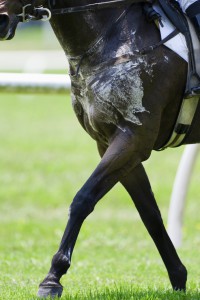We all know that we should feed electrolytes after our horse has been sweating a lot, but many people do not know what they are, and why they are important. Our Nutritionist Olivia Colton MSc explains…

What are electrolytes?
The science bit! Electrolytes are compounds that when in a solution become charged ions that conduct electricity. Because of this, they are of high importance as a part of electrical signals within the body, especially those which regulate muscle contractions and nerve transmissions. The major electrolytes are Sodium, Chloride, and Potassium; Calcium and Magnesium are lost in smaller volumes. Maintaining the correct amount of these ions is import for many bodily functions. One example, which shows how certain electrolytes are used in muscle contraction, is the following; in order for movement to occur, muscle fibres need to shorten. Nerve impulse signals are sent from the central nervous system to the relevant muscle cells. When this signal is received, channels within the muscle cells open, and sodium ions are funnelled in. This inwards rush of sodium into the muscle cell signals for calcium to be released from stores within (known as the Sarcoplasmic Reticulum), which results in muscle contraction. To relax the muscle, the same channel is opened, sodium flows out of the cell, calcium is returned to its stores, and the muscle is prepared to receive further signals.
The role of each electrolyte
The electrolytes present in horse's sweat are found at approximately the following levels: 56% Chloride, 27% Sodium, 15% Potassium and smaller amounts of Calcium and Magnesium.
Chloride: is a negative ion which is attracted to potassium and sodium. Lost in greater amounts than other electrolytes, this regulates the acid base in the body. If chloride levels drop blood pH can be affected, which can drastically impact normal bodily function.
Sodium: regulates fluid levels in the body by having an effect on blood osmolarity. Sodium is an important electrolyte that helps with electrical signals in the body, which allows the brain and muscles to function. It is half of the sodium-potassium pump, which keeps sodium in the plasma and potassium inside the cell.
Potassium: maintains turgidity in cells, and is involved with creating impulses which allow brain and muscle function. Horses will preferably excrete potassium over sodium, so it is important that this electrolyte is supplied to hard working horses.
Calcium: has an essential role in muscle contractions, including those of the heart. It is also heavily involved with bone formation, the nervous system and blood clotting. Magnesium: plays a part in over 300 bodily functions including normal muscle contraction and nerve transmission. Horses with magnesium deficiencies can often exhibit stressed behaviour.
How do horses lose electrolytes?
Electrolytes are lost daily through sweating, in urine and in faeces. The majority of electrolytes are lost during exercise, as sweat contains high levels of electrolytes. The horse relies on sweating to control body temperature, by dispersing heat created by working muscles. For a horse performing low intensity exercise in a moderate climate, these losses can normally be replaced adequately by electrolytes naturally present in the diet. However, during periods of exertion such as competition and training, electrolyte losses can be considerable, particularly during hot weather. Even under normal exercise conditions, a 500kg horse may lose 10 litres of sweat during two hours of exercise. This sweat would contain approximately 60g of Chloride, and almost 30g of sodium!
What happens when the horse doesn't have enough electrolytes?
Water alone does not efficiently restore bodily functions and performance after sweat loss.
- Electrolyte loss leads to low blood osmolarity, which inhibits the horses thirst response. A loss of just 2% body water may have negative effects on performance, and further losses can dramatically impair the health of the horse, leading to dehydration, alongside many other clinical signs- dull coat, sunken eyes, dark urine, poor performance, fatigue, and even death in extreme circumstances
- Lack of effective thermoregulation- which may lead to overheating
- Muscle fatigue
- Sporadic Exertional Rhabdomyolysis
- Synchronous diaphragmatic flutter (thumps). This is usually due to low blood calcium but can also be caused by low levels of the other electrolytes. When an imbalance of electrolytes occurs, the electrical signal that causes the heart to contract is also passed through the phrenic nerve, which signals the diaphragm to contact (usually this makes the horse breathe). If you look at the horse, you can see the contractions of the diaphragm with every heartbeat.
Using electrolytes:
To ensure that your horse doesn't suffer from problems due to lack of electrolytes, I would suggest that you feed regularly if your horse sweats through exercise, is in a hot environment or travels a lot, as with all medical and behavioural problems, prevention is better than cure. Replenish Contains:
- Calcium gluconate: essential for maintaining correct nerve transition and heart and muscle contractions
- Glucose: to provide muscle glycogen, promoting recovery after exercise
- Potassium chloride: aids oxygenation of muscles by dilating small blood vessels and maintain correct hydration levels
- Magnesium chloride: a co-factor for several functions, including maintenance of a normal fluid balance
- Sodium chloride: this maintains fluid balance, nerve and muscle function, and triggers the thirst response











